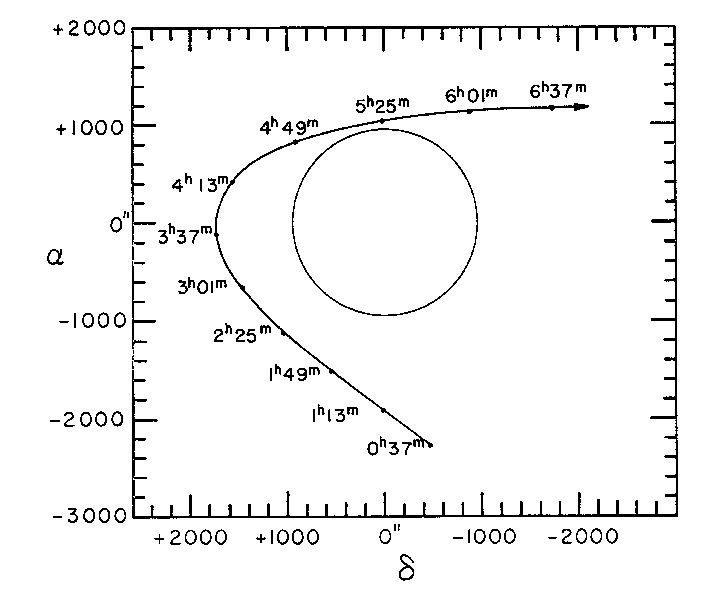Central Bureau for Astronomical Telegrams

IAUC 1930: 1965f; SN IN NGC 3631; PERIHELION PASSAGE OF 1965f
The following International Astronomical Union Circular may be linked-to from your own Web pages, but must not otherwise be redistributed (see these notes on the conditions under which circulars are made available on our WWW site).


 Read IAUC 1931
Read IAUC 1931
Circular No. 1930
Central Bureau for Astronomical Telegrams
INTERNATIONAL ASTRONOMICAL UNION
Postal Address: Central Bureau for Astronomical Telegrams
Smithsonian Astrophysical Observatory, Cambridge, MA 02138, U.S.A.
Cable Address: SATELLITES, NEWYORK
Western Union: RAPID SATELLITE CAMBMASS
COMET IKEYA-SEKI (1965f)
Precise positions have been reported as follows:
1965 UT R.A. (1950) Decl. Observer
Sept.24.14265 9 06 52.53 - 9 55 47.2 A
24.14439 9 06 52.71 - 9 55 49.1 A
25.13602 9 11 26.01 -10 11 15.3 A
25.14348 9 11 28.05 -10 11 22.7 A
25.14639 9 11 28.70 -10 11 24.6 A
Oct. 1.80521 9 48 08.91 -12 03 52.6 T
1.80714 9 48 09.66 -12 03 54.7 T
1.80920 9 48 10.51 -12 03 56.6 T
3.51473 9 59 45.60 -12 35 21.3 M,VB
3.80868 10 01 50.12 -12 39 35.2 T
3.81304 10 01 52.76 -12 39 39.3 T
6.15313 10 19 54.18 -13 20 47.8 A
6.41400 10 22 04.03 -13 25 18.0 M
6.41887 10 22 06.43 -13 25 23.5 M
6.42461 10 22 09.70 -13 25 28.0 M
6.43007 10 22 12.34 -13 25 35.5 M
6.43428 10 22 14.23 -13 25 41.3 M
A. Antal - Skalnate Pleso Observatory. Nuclear mag. 8 (Oct. 6).
T. Tomita - Tokyo Observatory. Total mag. 5 (Oct. 1),
4 (Oct. 3).
M,VB. Observer, Milon; Measurer, Van Biesbroeck - Steward Observatory,
Tucson, Arizona.
M. Miranian - U.S. Naval Observatory, Washington.
The following continuation to the ephemeris on IAUC 1928 has
been calculated at the Smithsonian Astrophysical Observatory from
Dr. L. E. Cunningham's elements:
.
1965 TT R. A. (1950) Decl. Delta r D Elong. Mag.
Oct. 22 13 25.27 -10 50.6 1.027 0.090 +16.0 4.8 -4.4
23 13 13.39 -11 44.0 1.034 0.157 + 8.0 8.6 -2.0
24 13 04.34 -12 33.9 1.038 0.212 + 5.8 11.8 -0.6
25 12 56.75 -13 21.0 1.041 0.262 + 4.8 14.6 +0.3
26 12 50.08 -14 06.3 1.043 0.307 + 4.1 17.1 1.0
27 12 44.06 -14 50.0 1.045 0.349 + 3.6 19.5 1.5
Nov. 1 12 19.57 -18 13.2 1.053 0.531 + 1.8 29.8 3.4
6 11 59.60 -21 21.0 1.057 0.686 + 0.5 38.8 4.5
11 11 41.22 -24 19.5 1.057 0.825 - 0.4 47.2 5.3
16 11 22.99 -27 10.4 1.055 0.953 - 0.8 55.2 5.9
21 11 03.96 -29 53.0 1.052 1.074 - 0.7 63.0 6.4
26 10 43.43 -32 24.4 1.051 1.188 - 0.1 70.7 6.9
Dec. 1 10 21.02 -34 29.9 1.052 1.297 + 1.1 78.3 7.2
6 9 56.55 -36 33.3 1.058 1.401 + 3.0 85.8 7.6
11 9 30.21 -37 57.8 1.070 1.502 + 5.4 92.9 7.9
16 9 02.60 -38 47.5 1.090 1.599 + 8.4 99.8 8.2
21 8 34.73 -38 59.5 1.119 1.694 +11.5 106.0 8.5
26 8 07.62 -38 33.6 1.157 1.786 +15.1 111.5 8.8
SUPERNOVA IN NGC 3631
Dr. Paul Wild, Astronomisches Institut der Universitat Bern,
writes that he found a supernova of about magnitude 16 in NGC 3631
(Ursa Major) on the morning of September 25. Bad weather delayed
confirmation until October 4, when it appeared a little fainter.
Prof. L. Rosino, using the 122 cm reflector at Asiago Observatory,
also confirmed the supernova on October 4. The type is not yet
known. The one previous supernova observed in this galaxy was
discovered with the 16" Schmidt at the Bern observing station at
Zimmerwald in February 1964, and according to Dr. Zwicky was of
type V (eta Carinae-like).
PERIHELION PASSAGE OF COMET IKEYA-SEKI (1965f)
The following diagram supplied by Dr. L. E. Cunningham
is a graph of the data on IAUC 1928. It gives positions of
the comet in universal time including light time for 1965
October 21. The semi-diameter of the sun is 966":
 1965 October 11 (1930) Owen Gingerich
1965 October 11 (1930) Owen Gingerich


 Read IAUC 1931
Read IAUC 1931
Our Web policy. Index to the CBAT/MPC/ICQ pages.